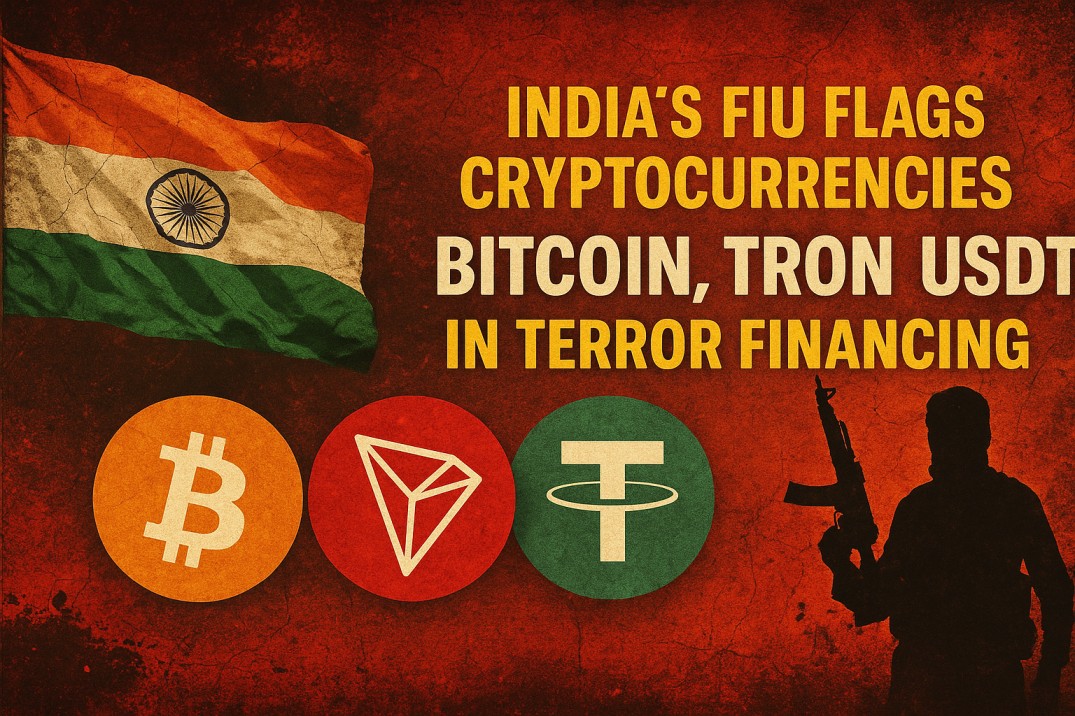Reviewed By Manu, April 27, 2025
Cryptocurrencies like Bitcoin, Tron, and Tether (USDT) have long been celebrated for their potential to revolutionize finance, offering decentralized, borderless, and fast transactions. However, a recent report from India’s Financial Intelligence Unit (FIU-India) has cast a shadow over these digital assets, highlighting their misuse in serious crimes such as terror financing, cybercrime, and narcotics trafficking. Released on April 27, 2025, the report has sparked intense debate about the future of cryptocurrencies in India, raising questions about regulation, national security, and the balance between innovation and oversight. This article explores the findings, their implications, and what they mean for India’s crypto ecosystem.
The FIU-India Report: Unmasking Crypto’s Dark Side
The FIU-India, the country’s premier agency tasked with combating money laundering and terrorist financing, compiled its typologies report for virtual digital assets (VDAs) during the 2023-24 financial year. The report is based on an operational analysis of suspicious transaction reports (STRs) submitted by crypto exchanges and other financial entities. These STRs flagged transactions that appeared unusual or potentially linked to illicit activities. The findings are alarming, pointing to a pattern of cryptocurrency misuse that threatens both financial stability and national security.
According to the report, cryptocurrencies such as Bitcoin, Tron, and USDT are “widely used by illicit actors” due to their widespread acceptability, relative stability in value (especially for stablecoins like USDT), and the ease with which they can be moved across borders. The report identifies several key areas where these digital assets are being exploited:
- Terror Financing: Cryptocurrencies are being used to fund terrorist activities and secessionist movements. The report notes high-volume transactions in “sensitive” regions, often linked to hawala networks and online gaming platforms, which serve as fronts for funneling money to terrorist groups.
- Cybercrime: Proceeds from hacking, ransomware, and other cyberattacks are being laundered through cryptocurrencies. Mule accounts—bank or crypto accounts controlled by third parties—are frequently used to receive large deposits from offshore exchanges or un-hosted wallets, making it difficult to trace the funds.
- Narcotics Trafficking: The anonymity and speed of crypto transactions make them a preferred choice for drug cartels. The report highlights cases where Bitcoin and USDT were used to facilitate payments in the illegal drug trade.
- Illegal Betting and Gambling: Cryptocurrencies are fueling unregistered online betting platforms, which often operate in violation of Indian laws.
- Child Sexual Abuse Material (CSAM): Disturbingly, the report also links cryptocurrencies to the distribution of CSAM, with payments for such content being made through digital assets to evade detection.
- Other Illicit Activities: The report flags the use of cryptocurrencies in pump-and-dump schemes involving fake tokens, illegal forex trading apps, and attempts to onboard individuals from sensitive regions suspected of unlawful activities.
The FIU-India emphasized that these findings are based on “suspicion” and not conclusive evidence, but the trends are concerning enough to warrant action. The agency has shared its intelligence with law enforcement bodies like the Enforcement Directorate (ED), Central Bureau of Investigation (CBI), and Income-Tax Department, leading to enforcement actions in several cases.
Why Cryptocurrencies Are Attractive to Criminals
To understand why cryptocurrencies are being exploited, it’s important to examine their unique features. Unlike traditional financial systems, cryptocurrencies operate on decentralized blockchain networks, which can offer a degree of anonymity when used with tools like VPNs or un-hosted wallets (wallets not tied to regulated exchanges). Stablecoins like USDT, pegged to the US dollar, provide price stability, making them ideal for illicit transactions where value retention is crucial. Tron, with its low transaction fees and fast processing, has also gained traction among bad actors, particularly for USDT transactions on its TRC-20 protocol.
The report notes that offshore crypto exchanges and un-hosted wallets are frequently used to launder proceeds of crime. These platforms often operate outside India’s regulatory reach, complicating efforts to track or freeze illicit funds. Additionally, the use of VPNs allows criminals to mask their locations, while mule accounts create layers of separation between the crime and the perpetrator. This sophisticated ecosystem enables illicit actors to move money quickly and discreetly, posing a significant challenge for law enforcement.
India’s Regulatory Response: A Tightening Grip
India’s relationship with cryptocurrencies has been turbulent. While the country has not banned digital assets outright, the Reserve Bank of India (RBI) has consistently expressed concerns about their impact on macroeconomic and financial stability. Since 2022, income from crypto transactions has been taxed at a flat 30%, and in March 2023, India introduced stringent regulations under the Prevention of Money Laundering Act (PMLA). These rules mandate that all crypto exchanges register with FIU-India as reporting entities and submit STRs for suspicious activities. Other financial institutions, such as banks and non-banking financial companies, are also required to monitor and report crypto-related transactions.
The FIU-India report underscores the need for even tighter regulations. The Central Economic Intelligence Bureau (CEIB), another agency under the Union Finance Ministry, submitted a report in 2023 recommending the establishment of a dedicated crypto regulator. The FIU’s findings could accelerate these efforts, potentially leading to:
- Stricter KYC/AML Requirements: Exchanges may face more rigorous know-your-customer (KYC) and anti-money-laundering (AML) protocols to prevent the use of mule accounts and unregistered platforms.
- Higher Taxes: The government could increase taxes on crypto transactions to deter speculative trading and curb illicit use.
- Enhanced Tracking Mechanisms: Blockchain analytics tools could be deployed to trace transactions and identify illicit wallets, even on decentralized networks.
- Crackdowns on Offshore Exchanges: The report highlights the role of unregistered offshore platforms, which may prompt India to take action against non-compliant exchanges servicing the Indian market. In December 2023, FIU-India issued show-cause notices to nine offshore exchanges, including Binance and Kraken, for operating without registration.
These measures aim to balance the need for innovation with the imperative to protect national security. However, they could also dampen India’s crypto market, which has seen rapid growth in recent years. The report acknowledges that VDAs have gained popularity among investors and traders, driven by their potential to transform the financial sector and create wealth. Striking the right balance will be a delicate task for policymakers.
Geopolitical Context: India-Pakistan Tensions
The timing of the FIU-India report is significant, as it coincides with heightened tensions between India and Pakistan. Posts on X have linked the report to recent unrest near Pahalgam and broader geopolitical concerns, suggesting that cryptocurrencies may be fueling cross-border illicit activities. While the report does not explicitly mention Pakistan, it references “sensitive” regions and foreign actors, which could imply concerns about state-sponsored or cross-border terror financing. This context has amplified calls for swift regulatory action, with agencies like the ED, CBI, and RBI on high alert.
Global Parallels: Cryptocurrency and Crime
India’s concerns are not unique. Globally, cryptocurrencies have been linked to illicit activities, prompting varied responses. The Financial Action Task Force (FATF), an international anti-money-laundering watchdog, has urged countries to strengthen oversight of crypto transactions. In 2024, FATF noted that India was “moderately effective” in prosecuting money laundering cases, citing court backlogs as a challenge. The FIU-India report aligns with FATF’s recommendations, signaling India’s commitment to addressing these risks.
Elsewhere, the United States has sanctioned crypto wallets linked to terrorist groups like the Houthis, while blockchain analytics firms like Chainalysis and TRM Labs have reported a rise in stablecoin use for illicit activities. For instance, TRM Labs noted a 125% increase in USDT addresses receiving funds for terror financing on the Tron blockchain in 2023. These global trends underscore the need for coordinated international efforts to combat crypto-related crime.
The Crypto Community’s Response
The FIU-India report has sparked a polarized reaction within India’s crypto community. On one hand, crypto enthusiasts argue that the technology itself is neutral and that its misuse should not lead to blanket restrictions. They point out that cash and traditional banking systems are also used for illicit purposes, yet they face less scrutiny. On X, some users have described the report as a “crypto nightmare” but maintain that regulatory overreach could stifle innovation. Others fear that tougher rules and higher taxes could drive crypto trading underground, ironically fueling the very black-market activities the government seeks to curb.
On the other hand, critics of cryptocurrencies see the report as validation of their concerns. They argue that the anonymity and global reach of digital assets make them inherently risky, especially in a country like India, which faces significant security challenges. The report’s findings could sway public opinion against cryptocurrencies, making it harder for the industry to gain mainstream acceptance.
What’s Next for India’s Crypto Landscape?
The FIU-India report is a wake-up call for policymakers, regulators, and the crypto industry. While the findings are based on suspicion rather than definitive proof, they highlight vulnerabilities that cannot be ignored. India is likely to move toward a more robust regulatory framework, potentially including a dedicated crypto regulator, enhanced blockchain surveillance, and stricter enforcement against offshore platforms.
For crypto investors and traders, the road ahead may be bumpy. Tighter regulations could increase compliance costs for exchanges, leading to higher fees or reduced services. Higher taxes might deter casual traders, while aggressive tracking could raise privacy concerns. However, a well-regulated crypto market could also boost legitimacy, attracting institutional investors and fostering long-term growth.
The challenge lies in crafting policies that curb illicit use without stifling innovation. Cryptocurrencies have the potential to democratize finance, enable cross-border trade, and drive financial inclusion in a country where millions lack access to traditional banking. But without addressing the risks, India risks missing out on these benefits while grappling with the fallout of unchecked criminal activity.
Conclusion: A Balancing Act
The FIU-India report has thrust cryptocurrencies into the spotlight, exposing their dual nature as both a tool for innovation and a weapon for crime. As India navigates this complex landscape, the government must balance the need for security with the promise of technological progress. For now, Bitcoin, Tron, and USDT remain under scrutiny, and the crypto community waits anxiously to see how the regulatory pendulum will swing.
The stakes are high, not just for India but for the global crypto ecosystem. As one of the world’s largest markets, India’s actions could set a precedent for other nations grappling with similar challenges. Whether cryptocurrencies emerge as a force for good or a persistent threat depends on the choices made in the months ahead. For now, the message is clear: the promise of digital assets comes with a shadow that cannot be ignored.
Sources: Information compiled from publicly available reports and news articles, including statements from FIU-India, PTI, and posts on X, as of April 27, 2025. No direct excerpts or copyrighted material were used.







